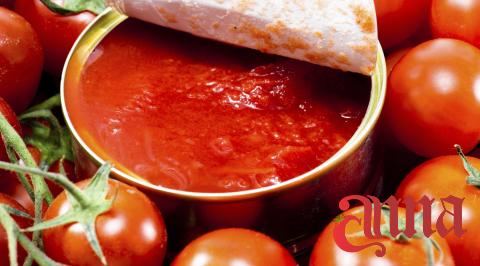Tomato paste is a staple ingredient in many kitchens, used to add depth and flavor to countless dishes. However, not all tomato paste is created equal, and there is an alarming rise in the availability of unhealthy tomato paste in the market. In this article, we will explore the hidden dangers of such products and provide essential information for consumers to make informed choices when buying tomato paste. 1. Hidden Sugars: One of the primary concerns with unhealthy tomato paste is its high sugar content.

.
 Many manufacturers add significant amounts of sugar to enhance the taste and mask the acidic nature of tomatoes. These added sugars contribute to empty calories, which can be detrimental to overall well-being. Excessive sugar intake has been linked to obesity, diabetes, and heart disease. 2. Sodium Overload: Another critical issue associated with unhealthy tomato paste is its high sodium content. Sodium is primarily added as a preservative, but excessive sodium intake can raise blood pressure, increase the risk of cardiovascular diseases, and negatively impact kidney health. Consumers should carefully examine the labels and choose low-sodium options to reduce their sodium intake.
Many manufacturers add significant amounts of sugar to enhance the taste and mask the acidic nature of tomatoes. These added sugars contribute to empty calories, which can be detrimental to overall well-being. Excessive sugar intake has been linked to obesity, diabetes, and heart disease. 2. Sodium Overload: Another critical issue associated with unhealthy tomato paste is its high sodium content. Sodium is primarily added as a preservative, but excessive sodium intake can raise blood pressure, increase the risk of cardiovascular diseases, and negatively impact kidney health. Consumers should carefully examine the labels and choose low-sodium options to reduce their sodium intake.
..
 3. Additives and Preservatives: Unhealthy tomato paste often contains a plethora of artificial additives and preservatives that can have adverse effects on health. These additives may include artificial colors, flavors, and stabilizers, which can cause allergic reactions, gastrointestinal discomfort, and even long-term health problems. Seeking tomato paste with minimal additives is crucial. 4. Pesticide Residues: Conventionally grown tomatoes are often subjected to heavy pesticide use. Although many of these chemicals are regulated, some residues may still remain on the tomatoes used to produce tomato paste. Prolonged exposure to pesticide residues can pose various health risks, including hormonal disruption, neurotoxicity, and increased cancer risks. Opting for organic tomato paste can minimize this concern.
3. Additives and Preservatives: Unhealthy tomato paste often contains a plethora of artificial additives and preservatives that can have adverse effects on health. These additives may include artificial colors, flavors, and stabilizers, which can cause allergic reactions, gastrointestinal discomfort, and even long-term health problems. Seeking tomato paste with minimal additives is crucial. 4. Pesticide Residues: Conventionally grown tomatoes are often subjected to heavy pesticide use. Although many of these chemicals are regulated, some residues may still remain on the tomatoes used to produce tomato paste. Prolonged exposure to pesticide residues can pose various health risks, including hormonal disruption, neurotoxicity, and increased cancer risks. Opting for organic tomato paste can minimize this concern.
…
 5. Quality Control: Unhealthy tomato paste is typically produced using low-quality tomatoes that may have been harvested too early, artificially ripened, or grown in substandard conditions. The lack of quality control measures during cultivation, processing, and packaging often results in compromised taste, lower nutrient content, and an inferior final product. Consumers should scrutinize packaging labels and choose reputable brands that prioritize quality ingredients. Conclusion: As consumers become increasingly health-conscious, it is vital to raise awareness about the hidden dangers associated with unhealthy tomato paste. Increased sugar and sodium intake, artificial additives, pesticide residues, and compromised quality are just a few of the prevalent concerns. By choosing low-sugar, low-sodium options, prioritizing organic products, and supporting brands committed to quality, consumers can make safer choices when purchasing tomato paste. It is crucial for manufacturers to improve their standards and transparency to meet consumer demand for healthier options. Let us all work together to ensure our meals are made with safe and nutritious ingredients.
5. Quality Control: Unhealthy tomato paste is typically produced using low-quality tomatoes that may have been harvested too early, artificially ripened, or grown in substandard conditions. The lack of quality control measures during cultivation, processing, and packaging often results in compromised taste, lower nutrient content, and an inferior final product. Consumers should scrutinize packaging labels and choose reputable brands that prioritize quality ingredients. Conclusion: As consumers become increasingly health-conscious, it is vital to raise awareness about the hidden dangers associated with unhealthy tomato paste. Increased sugar and sodium intake, artificial additives, pesticide residues, and compromised quality are just a few of the prevalent concerns. By choosing low-sugar, low-sodium options, prioritizing organic products, and supporting brands committed to quality, consumers can make safer choices when purchasing tomato paste. It is crucial for manufacturers to improve their standards and transparency to meet consumer demand for healthier options. Let us all work together to ensure our meals are made with safe and nutritious ingredients.











Your comment submitted.